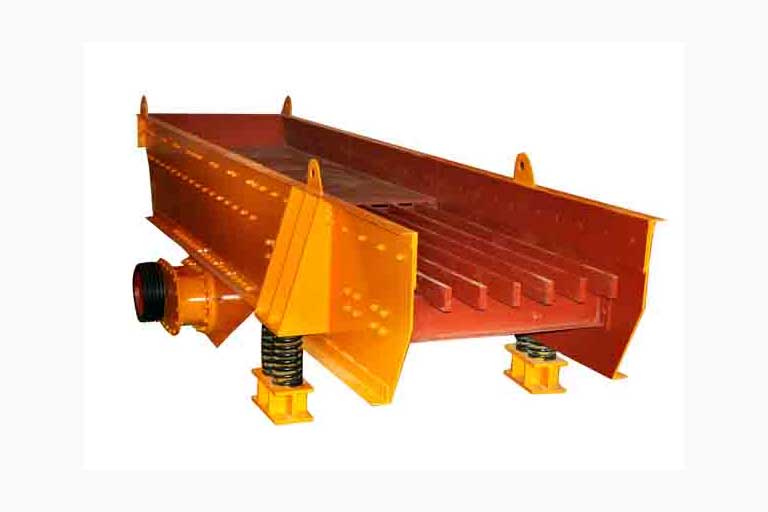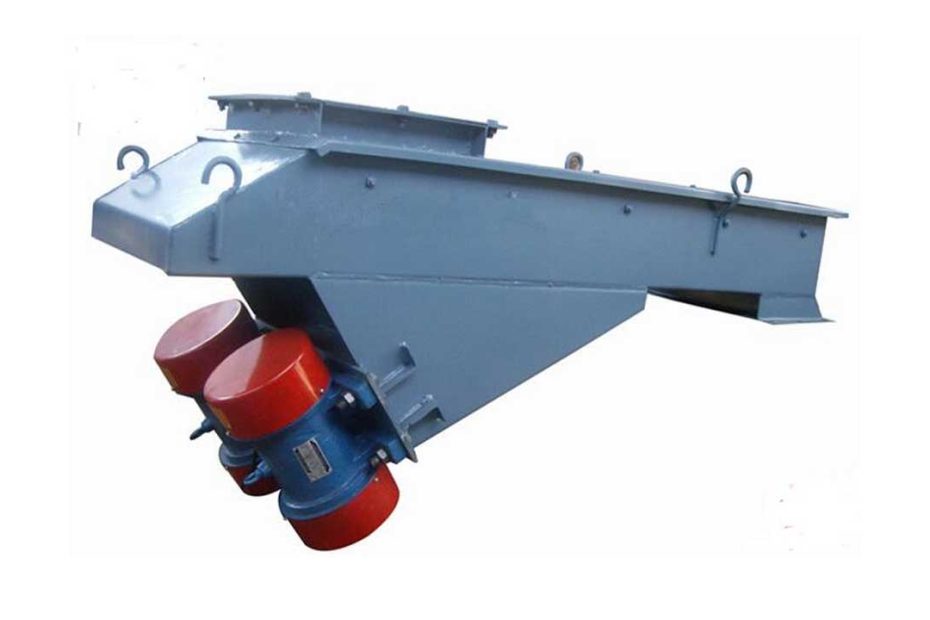The electromagnetic vibrating feeder uses the periodically changing electromagnetic force emitted by the electromagnetic exciter as the exciting force to maintain its long-lasting and stable vibration, and the electromagnetic exciting force generated by the electromagnetic exciter depends on the electromagnetic coil. Excitation mode, therefore, the excitation mode of the electromagnet coil directly determines the vibration of the electric vibration feeder.
At the same time, different excitation methods also directly affect the structure of the electromagnet and electromagnetic exciter, the overall structure of the electric vibration feeder and its adjustment method.
Design the excitation method of the electromagnet coil of the electric vibration feeder
AC excitation
That is, the alternating current passes directly through the electromagnetic coil, and the periodically changing electromagnetic force generated by this excitation method is continuous and decomposed into two parts: the constant electromagnetic force and the second harmonic force. The constant electromagnetic force makes the main vibration spring of the vibration system produce constant deformation; the second harmonic force makes the vibration system produce lasting and stable vibration. Therefore, the vibration frequency obtained by this excitation method is twice the frequency of the power supply, that is, 6000 times/min.
Due to the limitation of the dynamic strength of the body structure, the general design double amplitude is not more than 1mm. The electric vibration machine with such working parameters requires a relatively large spring stiffness due to its high frequency. Therefore, a large number of springs are required; at the same time, because of the high frequency, the dynamic stiffness of the body is required to be high; but because of the small amplitude used, the air gap of the required electromagnet is small, the magnetic flux leakage is small, and the current is also small. Due to the high frequency and small amplitude, according to the conveying speed formula, the conveying speed is lower under the same vibration intensity.
When this excitation method is used, the amplitude is usually adjusted by resistors, inductors or voltage regulators. When using resistance adjustment, the disadvantage is large power loss; when using inductor adjustment, the disadvantage is low power factor; when using voltage regulator adjustment, the disadvantage is that the control equipment is bulky, the cost is high, and the adjustment node is easy to burn. In addition, none of the above three adjustment methods can be automatically controlled. However, because this excitation method and the usual adjustment method are the simplest, it is widely used in micro-electric vibrators.
Half-wave rectification excitation
Generally speaking, the periodic electromagnetic force generated by this excitation method is discontinuous, but it can be decomposed into constant electromagnetic force, first harmonic force and second harmonic force. The first harmonic force is usually selected as the main harmonic force. The natural frequency of the main vibration system of the machine is close to the frequency of the first harmonic force, but far away from the frequency of the second harmonic force. The constant deformation of the main vibration spring of the machine and the amplitude of the second harmonic force are much smaller than the amplitude generated by the first harmonic force.
Therefore, the vibration frequency of the machine is the frequency of the first harmonic force; that is, 3000 times/min; the double amplitude usually used is 1~1.5 mm. Since the working frequency is half of the previous excitation method, the required spring stiffness and quantity are about one-fourth of the previous excitation method; the requirement for the dynamic stiffness of the body is also lower than the previous one; at the same vibration intensity However, due to the larger amplitude than the previous electric vibrator, the required air gap of the electromagnet increases correspondingly, the magnetic flux leakage increases correspondingly, and the power factor decreases accordingly.
For small and miniature electric vibration feeders, it is usually adjusted with a voltage regulator, inductor or resistor, but for medium and large electric vibration feeders, it is generally adjusted directly with a thyristor. Half-wave rectifier electric vibration feeder, its control equipment is small in size, light in weight, low in cost, wide in amplitude adjustment range, and easy to realize closed-loop automatic control, so it has been developed rapidly in the past ten years. However, when the thyristor half-wave rectifier is used for excitation, the power factor is low, especially when the amplitude is small, it should also be considered.
Half wave plus full wave rectification excitation
The periodic electromagnetic force generated by this excitation method is continuous, and can also be decomposed into three parts: constant electromagnetic force, first harmonic force and second harmonic force. Usually the first harmonic force is used as the main harmonic excitation force, the vibration frequency of the system is 3000 times/min, and the double amplitude usually used is 1~1.5 mm. Because the magnitude of the first harmonic force generated by this excitation method is related to the ratio of AC and DC magnetic density, the method of adjusting the DC voltage with a voltage regulator is usually used to adjust the amplitude.
This excitation method has a higher power factor than the half-wave rectification excitation, and has been used in large electric vibrators. However, due to the complex circuit of this excitation method; the electromagnet is easy to saturate; the voltage regulator is used for amplitude adjustment, the control equipment is bulky, and it is not convenient for automatic control, so it is gradually replaced by the excitation method of controllable half-wave rectification.
Controllable half-wave rectification intermittently triggers excitation
In this excitation method, the thyristor is triggered once at a certain interval, usually once every interval, so the vibration frequency obtained by this excitation method is 1500 times/min, and the required spring stiffness and quantity are half-wave rectification. One-fourth of the excitation method has lower requirements on the rigidity of the machine body. Under the same vibration intensity, the conveying speed is higher than that of the previous excitation methods. This excitation method adopts a larger amplitude (double amplitude 3~5 mm), which requires a large air gap of the electromagnet, large magnetic flux leakage, large current, and low power factor.

Factors Influencing Excitation Mode Selection
Several factors come into play when choosing the excitation mode for the electromagnet coil of an electromagnetic vibrating feeder:
- Frequency Requirements: The desired frequency of vibration is a vital factor in excitation mode selection. High-frequency vibrations are suitable for fine materials, while low-frequency vibrations are more effective for coarse materials. The excitation mode must align with the required frequency range for optimal material handling.
- Power Efficiency: Efficiency is paramount in any design. Different excitation modes have varying power requirements and efficiency levels. It’s essential to strike a balance between the power input and the desired output in terms of vibration amplitude and conveying capacity.
- Material Characteristics: The nature of the material being handled influences the excitation mode choice. Materials with cohesive tendencies might require a different excitation mode than free-flowing materials. The selected mode should prevent material clogging and ensure smooth flow.
- Feeder Size and Design: The size and design of the feeder apparatus also impact the excitation mode. Larger feeders may require different excitation modes to ensure uniform material distribution across the tray. The mode should accommodate the spatial constraints of the feeder.
- Maintenance and Durability: Certain excitation modes might subject the equipment to higher wear and tear. It’s important to consider maintenance requirements and the overall durability of the feeder when selecting the mode. A balance between performance and longevity is vital.
Conclusion
In addition to the above four types, there are controllable half-wave rectifiers to alternately trigger excitation, use frequency conversion machine or inverter to reduce frequency excitation, etc. However, among the various excitation methods mentioned above, the controllable half-wave rectification excitation is the most common.
Therefore, the following only analyzes the changing law of the exciting force and the changing law of the excitation coil current for the electric vibration feeder with controllable half-wave rectification excitation, so as to obtain the selection and calculation method of the electromagnetic system and control loop parameters of the electric vibration feeder . For other excitation methods, the principles are similar and will not be repeated here.
Selecting and designing the excitation mode of the electromagnet coil for an electromagnetic vibrating feeder requires a comprehensive understanding of various factors. The frequency requirements, power efficiency, material characteristics, feeder design, and maintenance considerations all play pivotal roles in making the right choice. Whether opting for AC or DC excitation, a well-thought-out design and careful implementation are essential for achieving optimal feeder performance across diverse applications.
